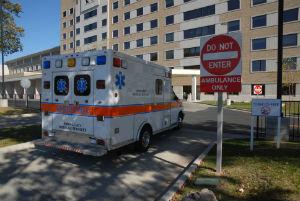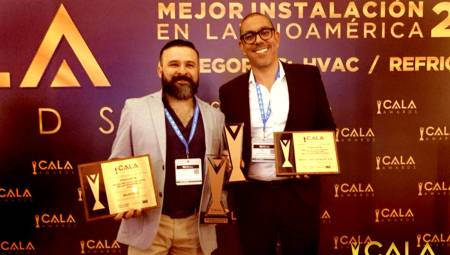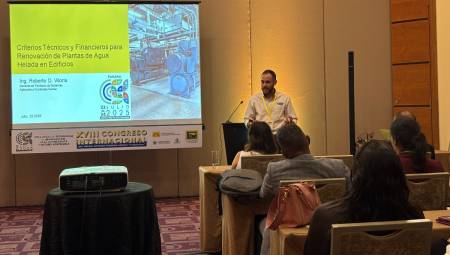 Contrary to what one might think about the natural ventilation installed in hospital premises, it is not only beneficial but, sometimes, mandatory and of great positive impact on the energy efficiency of a building and for human health.
Contrary to what one might think about the natural ventilation installed in hospital premises, it is not only beneficial but, sometimes, mandatory and of great positive impact on the energy efficiency of a building and for human health.
by María Cecilia Hernández Ocampo
With the awareness that has been widely implanted throughout the world about the care of the environment and, with it, of the health of people, today the trend is set by eco-sustainable or environmentally friendly buildings that, at the same time, offer comfort to those who inhabit them or are there in a transitory way.
Such is the case of hospital establishments that are no strangers to this trend. Natural ventilation (VN) is just one of the characteristics of this type of structure. But how healthy is it to integrate this type of ventilation into spaces that provide health services?
To solve this and other questions, ACR LATINOAMÉRICA interviewed Carlos Alberto Muñoz, manager of the company Ingeniería Bioclimática.
ACR: Natural ventilation is imposed on architectural design around the world What advantages does VN have over that generated with traditional energy sources?
Carlos Alberto Muñoz: VN does not necessarily exclude mechanical ventilation, sometimes the best solutions are hybrid. However, it has broad economic advantages if the project is in the design phase. The initial investment costs and, above all, the operating costs, under passive solutions, will be lower during the useful life of the building: the great advantage.
It is worth mentioning the ecological benefits (relationship of the human being with the environment), since generally the bioclimatic consultant, when making use of passive systems, does not demand energy or substantially reduces the dependence on non-renewable conventional energies. An opening made at the top end of a wall will never need maintenance and will evacuate hot air! In technified or technocratized Latin America, in the short term, it is not possible to do without traditional energy sources, but greater energy efficiency is possible, viable and necessary.
ACR: In a hospital, what are the benefits of VN?
CAM: In hospitals (institutions providing health services, public, private or mixed, in the phases of promotion, prevention, diagnosis, treatment and physical or mental rehabilitation) the VN avoids sudden changes in temperature that require a great effort for our body; going from 30°C to 23°C reduces the pulmonary defenses that work mechanically.
According to the Ministry of Health of Peru and the Pan American Health Organization (PAHO) "VN in general can provide a high ventilation rate at a lower cost, thanks to the use of natural forces and large openings. VN can have a higher energy efficiency, particularly if heating is not needed. A well-designed VN offers the possibility of better natural lighting."
ACR: Much has been said about the microbial and infectious consequences, fatal to human health, resulting from poor maintenance of artificial ventilation systems. How is this issue addressed in the VN?
CAM: PAHO also pronounces on this: "... The difficulties involved in the proper installation and maintenance of a mechanical ventilation system can lead to a high concentration of infectious droplet nuclei and, ultimately, lead to an increased risk of disease transmission."
Likewise, the World Health Organization (WHO) refers to the fact that since "exposure to nuclei of small infectious droplets generally cannot be eliminated, there are various methods of environmental control that can be used in high-risk areas to reduce the concentration of droplet nuclei in the air. Such measures include maximizing VN and controlling the direction of airflow."
These applications and the recommendations that are shown on them coincide in different authors, emphasize ventilation due to depression, shooting or negative pressure.
ACR: What elements should be taken into account in a hospital when designing the spaces that VN will have?
CAM: The location, like any other building that wants to be called bioclimatic; external polluting sources, orientation and prevailing winds at the site. Control strategies include everything from filtration, mechanical ventilation, design and use of space.
ACR: In which spaces of a hospital or a clinic can VN be applied?, does this depend on the type of climate (or city) where the hospital is located?
CAM: I will talk about the Colombian norm that is the one that I have closest because it is the country where I live and practice.
With regard to the resuscitation room: "it must have [...] and preferably have lighting and VN".
On hospitalization services: "they will be located in such a way that there is natural ventilation and lighting, that noise, odors are avoided [...]". And these services are: hospitalization rooms, nursing post or station, nursing work room, healing and treatment room, medicine depot and linen deposit.
It is also advised for kitchen and laundry services. The standard also expressly allows it for maintenance areas such as workshop, boilers, water purification equipment, emergency power plant, gas tank, oxygen supply, garbage incinerator, etc.
ACR: And in spaces that can be assumed to be of greater care such as operating rooms, is it possible to have VN?
CAM: In some way, both in obstetric services and in operating rooms, the use of VN is allowed because the standard says that: "If windows are raised to open in the operating rooms, you must have a control of the opening of swingarms to avoid risks of contamination."
Of the morgue service it says: "it must be located in a place that allows the easy evacuation of the corpse; their access should be restricted and different from patient access. It must also have a VN and/or artificial system."
ACR: Is hospital NV equally beneficial in tropical cities as in stationary climates, or are there different restrictions, designs, or care depending on the location and climate?
CAM: Stationary climates require, with greater reason, to consider mechanical or hybrid ventilation, since it is not possible, for example, to keep a window open all year round in Canada or Chile. In tropical climates it is feasible to maintain an average temperature and it will always be possible to print movement to the air.
From the IB we are able to design and install thermal or solar chimneys (black bodies) that generate a sufficient shot and capable of replacing an extractor with an electric motor, with the advantage of generating emissions towards a point of discharge that does not pollute neighbors. Sure, it's no secret that bacteria proliferate with high temperatures, and if the temperature can't be properly controlled and the VN doesn't contribute to enough air renewals, its application won't be feasible.
Now, economically and socially, another situation arises sometimes impalpable from certain latitudes. The condition of tropical cities globally is associated with poor countries, and poor countries do not always have the best equipped hospitals: then this will be another opportunity to call for bioclimatic and its reasonableness.
ACR: It has been stated that ventilation and air conditioning equipment can increase the focus of bacteria and contamination that occurs for multiple reasons (bad installation, bad design, poor maintenance, miscalculation of needs, etc.), how are these risks minimized with VN, taking into account environmental pollution and bacteria that exist naturally in the environment?
CAM: We would do badly to disqualify mechanical ventilation, in many spaces it will always be necessary. The biggest criticism does not concern the manufacturer or supplier, but the user, who does not apply the appropriate maintenance programs.
However, as the standard to which I have alluded assures, we cannot ignore that "Almost all surgical infections are acquired during the intervention, that is, etiological agents reach the patient's tissues from some source during the operation and the main sources of infection are:
Environment: primary air pollution caused mainly by technical problems (filter deficiency, incorrect design of surgical facilities, irregular flows between premises).
Health personnel: the presence of people results in secondary air pollution, which is more important than primary air pollution and more difficult to control."
According to the WHO "[...] the patient's organism is the main reservoir for the development of a surgical infection."
We left stated in the previous point the possibility, even, of naturally ventilating operating rooms in tropical cities. The question that may have a positive answer is: could tropical patients, who live with tropical bacteria, more easily overcome operations in conditions that a first-world human organism would not withstand?













